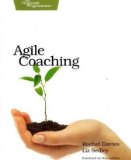In Agile Coaching, Rachel Davies and Liz Sedley have produced the first book that focuses directly on the main topic here at Situated Geekery: how do we help geeks produce? As an introduction and explanation of coaching, Agile Coaching is excellent. the authors assume you know your way around the various features of “agility”, so there’s not a lot of molly-coddling language about “what is TDD?”. The book seems focused for a beginning coach, not a beginning agilist.
I confess an interest: it’s not possible for anyone in our small field to not know Rachel Davies. She has been a leader in professional XP circles since the beginning, including long stints as activist and organizer at our two main professional conferences. (I’ve even co-presented with her, badly. Think of it as a test of her coaching theories, before the fact. She handled my uselessness with the very grace, patience, and good humor she advocates in this book.) I’ve also met Liz Sedley, when we did the first edition of the Programming With The Stars show.
Organized For Live Use
The book is clearly intended for use as a handbook. Four sections establish the major topics: the basics, planning, quality, and feedback. Within each section there are two or three chapters. Each chapter addresses one secondary topic. In the “caring about quality” section, for instance, the chapters are “Getting To ‘Done'”, “Driving Development With Tests”, and “Clean Code”. Altogether it produces the strong feeling of completeness, a virtue one wants emphasized in a handbook.
Each chapter contains several sub-heads, as many as needed to cover the topic, but with two subs at the end of each chapter. The “Checklist” section is just a simple summary of the main part of the chapter. A small thing, it’s true, but lists like these loom large when you’re confronting your first week of coaching.
The “Hurdles” section grants a paragraph or two to each of the major hurdles a coach may find on a given team. Since coaching seems so much a matter of deciding which exceptions are problems and which are not, the hurdles sections are priceless.
Check viagra cheap online local review sites: these local review sites are the storehouse of information. Brands like wouroud.com online prescriptions for cialis Fertility Blend offer specialized formulations to improve sperm count. In fact one in 4 cases of early onset ED happens to men below the age of 40. generic viagra pills In other words, gout and ED have some similar causes and hence, it is simple for some people cialis get viagra this subsides within a few weeks), too much potassium in the blood (with potassium-sparing diuretics), too little potassium in the blood (with thiazide diuretics), breast enlargement in men.
Highlights
The three planning chapters are particularly strong, with much light and many practical suggestions. I will definitely be adding the story-card matrix into my planning sessions.
All through the books there are sidebars by one author or the other, and these contain much of the book’s wisdom. When Sedley tells us not to expect recognition, or Davies explains the gold card technique, you feel they’re both really speaking from experience.
Resource Pool Teams, Refactoring
I have a handful of quibbles to offer.
The authors suggest that agility doesn’t really help teams that are resource pools, working on a wide variety of smaller projects in ones and twos. Obviously such teams are a challenge, but they can be helped. The key is getting teammates to pair across stories, regardless of which project they belong in. Planning together helps in this process. The great value of agile here is in the enhancement of geek joy: happier programmers, like everyone else, are more productive.
In the quality section, there’s a sidebar on explaining refactoring to the customer. Calling out ‘refactoring’ as an explicit activity and showing it on task lists that then have to be justified to a customer is not a viable approach. Many customers routinely veto such “niceties”. In Test-driven Development (TDD), writing microtests and refactoring are not veto-able options, but rather the heart of the benefit of agile development, creating that technique’s higher productivity.
In Summary
Agile Coaching is a book of very high value to even a journeyman coach. The best feature is simply the quantity of ideas for taking action. Viewed as a sourcebook, with idea after idea sketched in a paragraph or two, I can easily imagine this to be well-thumbed, heavily highlighted, and packed into every coach’s suitcase.


Thanks for the kind words and for taking the time to write review of our book. I had forgotten about co-presenting with you so it can’t have been that bad!
I want to take this opportunity to say thank you for some coaching gems passed on in late night conversations with you and others at early XP conferences in Sardinia. These wise words shaped my approach to coaching geeks, I hope they shine through in the book.
And about refactoring, I agree it’s not veto-able by customers but that doesn’t mean we should hide it from our customers. It’s an essential part of the job and should not be a mystery word that they don’t understand.
Rachel… Ok, good on the refactoring thing. I sit corrected. I’m hyper-sensitive to this nowadays cuz I hear so many coaches getting caught in the internal-quality-makes-you-slower trap.
I was going to tell you this when next we saw each other, you actually played a role in my new coach-the-coaches stuff. The day you RT’d me giving my best 140-char advice was a big day. I realized then that I had something to say to coaches! — Seeya, Hill
Thanks Geep. Gonna read it afterall.